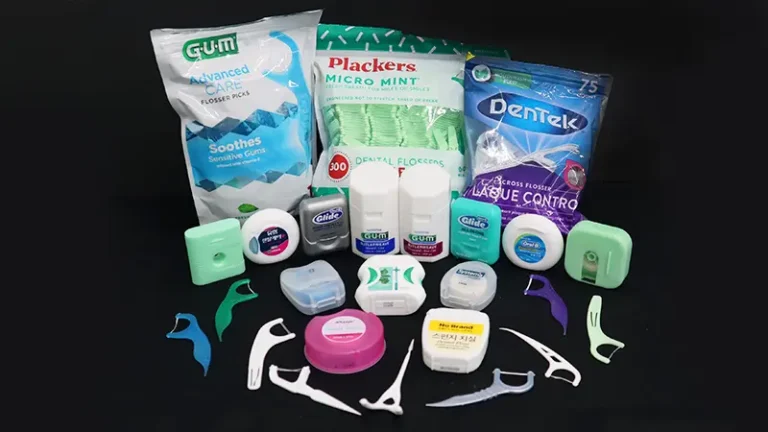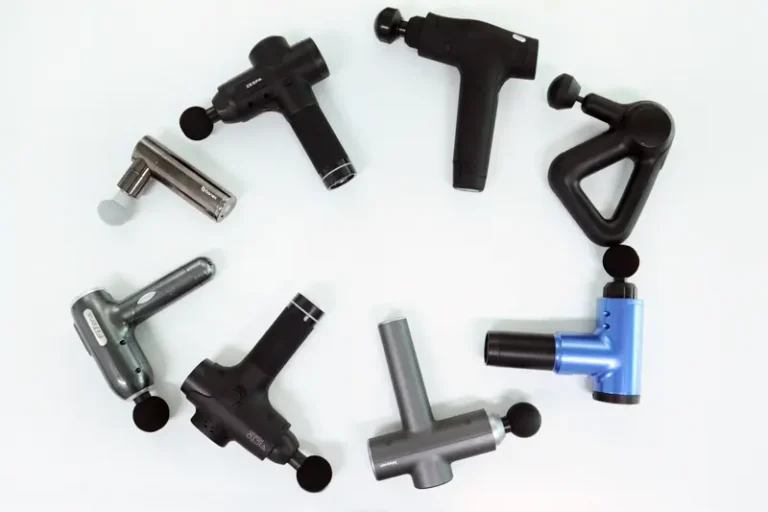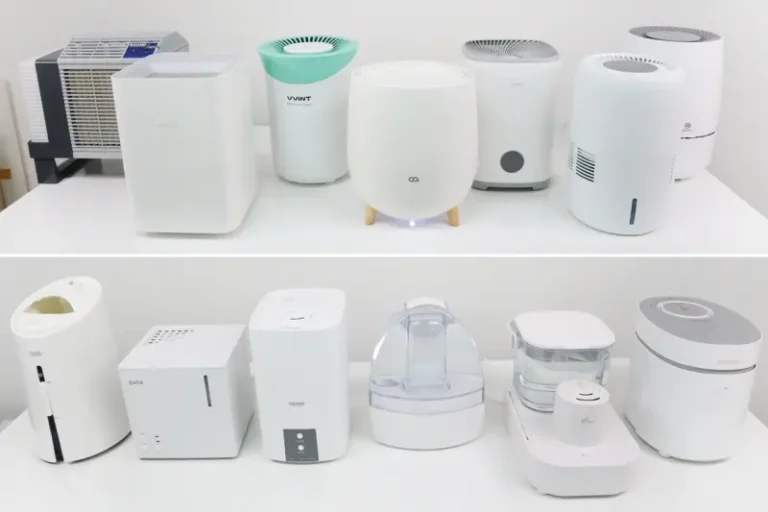The Best hair dryers Buying Guide
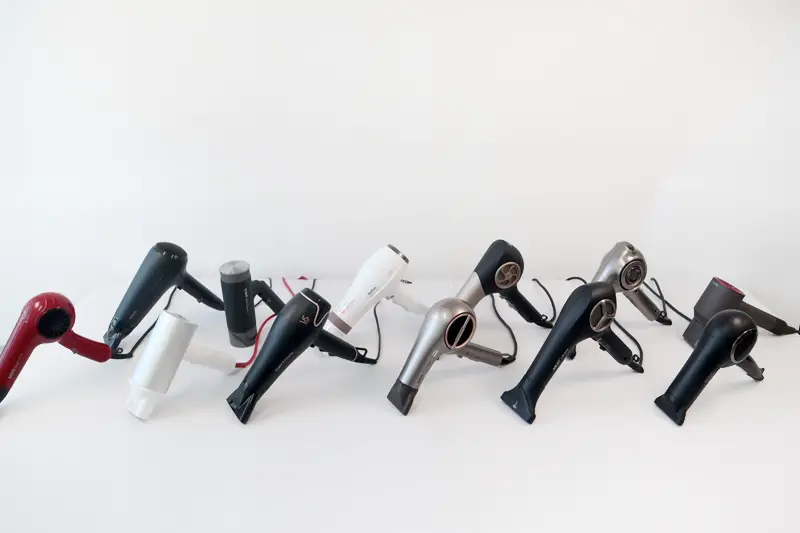
Your Essential Guide to Choosing the Perfect Hair Dryer!
Whether you’re rushing to dry your hair in the morning or looking to style it, a hair dryer is a staple appliance in most households.
Recently, as more consumers have become conscious about hair and scalp care, they’re paying closer attention to the specific features and functions of hair dryers.
This increased interest has led to a wide range of products in the market, with prices ranging from $7 to nearly $370. Let’s examine step by step how to choose the right hair dryer for your needs.
Chapter 1.
hair dryer Air Power
Four Factors That Determine Air Power
1. Operating Mechanism
Heat Generation and Air Flow System
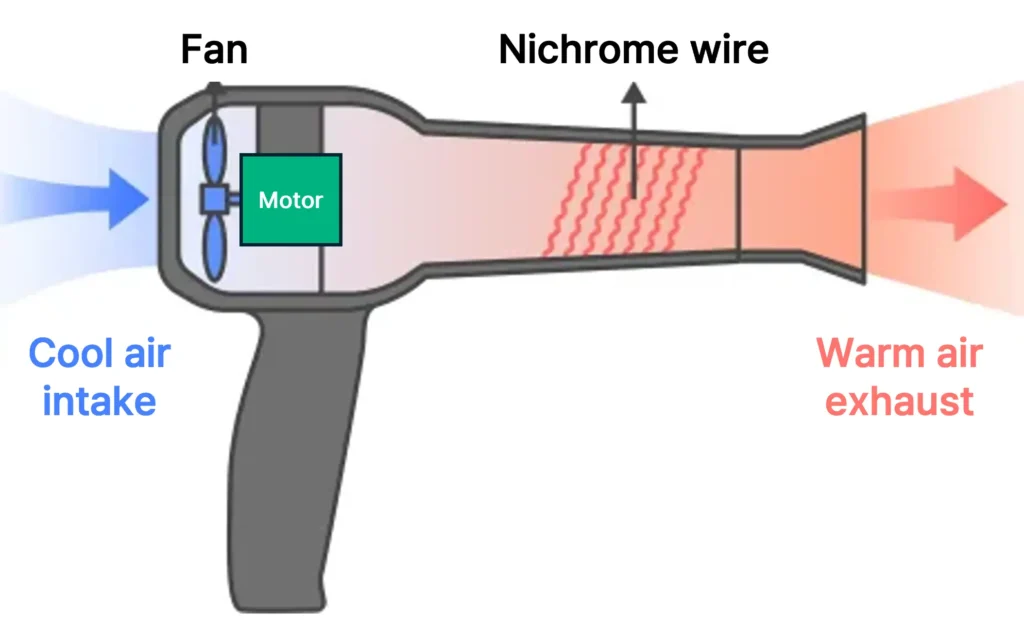
A hair dryer works by generating heat through nichrome wires and producing airflow using an electric motor. Here’s the basic three-step process:
1) Intake: The motor draws in air through the inlet
2) Heating: The nichrome wire heats the incoming air
3) Output: The heated air flows through the vent and out through the nozzle In cool shot mode, the heating step is skipped.
2. hair dryer Motor
For Long-Term Use, Choose a BLDC Motor
DC Motors Are Cheaper but Less Durable
The motor is the most crucial component determining a hair dryer’s performance and durability. Hair dryers use either DC motors or BLDC motors.
While DC motors are commonly used due to their simple structure and low cost, they’re less efficient and may lose power or break down after extended use. Recently, more products are featuring BLDC motors to address these DC motor limitations.
BLDC Motor Advantages:
1)Durability 2)High Efficiency 3)Quiet Operation

BLDC (Brushless DC) motors operate using electromagnetic fields without wear-prone brush components.
This design results in quieter operation and exceptional durability for semi-permanent use.
Their high efficiency means less energy loss from friction, producing stronger airflow than DC motors with the same power consumption. They’re also more compact, allowing for smaller overall product designs.
BLDC Motors:
Higher Cost but Becoming More Affordable
Despite their advantages, BLDC motors are more expensive due to their complex control circuits. While DC motor dryers typically cost $7 to $37, BLDC models often range from $52 to $148.
However, as BLDC products become more common, prices are dropping, with some models now available for $37 to $44. For those seeking a high-performance dryer for long-term use, we recommend choosing one with a BLDC motor.
3. Body Structure
For Stronger Airflow,
Choose Models with Narrow Body and Output Area
Narrower Body Means Stronger Airflow
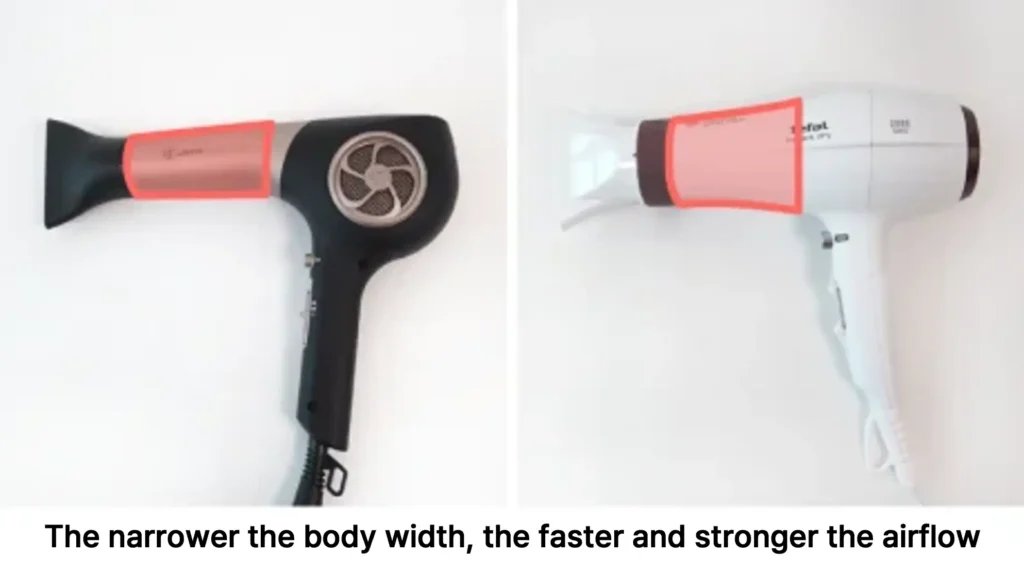
When air passes through the dryer’s body, a narrower width creates faster, stronger airflow. This follows the Venturi effect*, similar to how water flows more forcefully when you partially block a hose’s end with your finger.
In our tests, models with narrower bodies produced stronger airflow than similar-spec products with the same power consumption. For powerful airflow, look for models with a body width around 2 inches.
Venturi effect: The phenomenon where fluid velocity increases and pressure decreases when flowing through a constricted section of a pipe.
Narrower Output Area Produces Stronger Airflow in Similarly-Sized Bodies
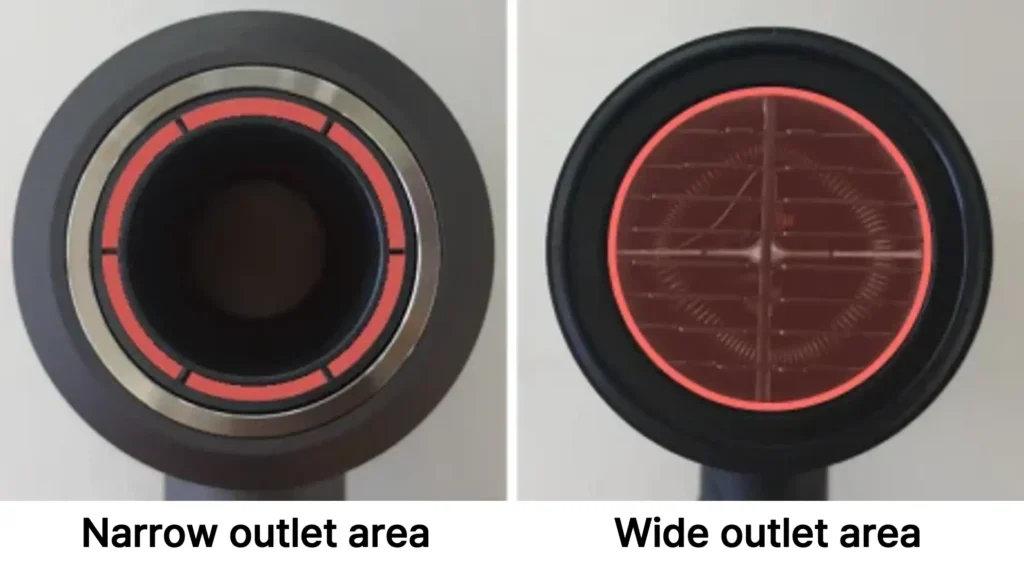
Following the same principle, models with narrower output areas produce faster, stronger airflow when body sizes are similar. For example, while Dyson models have wide bodies, their narrow air output areas create powerful airflow.
In contrast, similar-style products from other brands often have wider output areas, resulting in weaker airflow.
4. hair dryer Power Consumption
Higher Wattage Means Stronger Airflow
Recommend 1500W+ for BLDC Motors
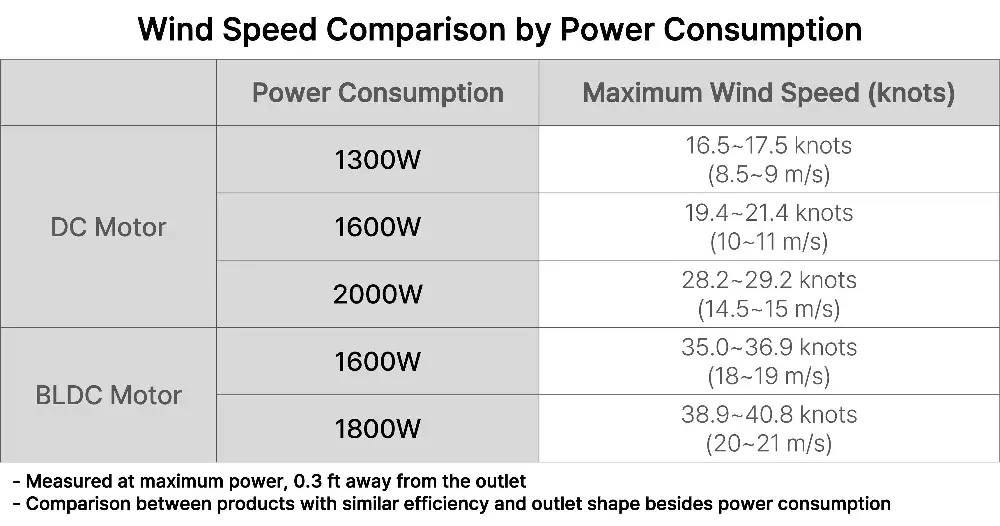
While higher power consumption generally means stronger airflow, BLDC motor models or those with narrow bodies can produce strong airflow even at lower wattages.
Consider power consumption after evaluating motor type and body structure. Our tests of over 10 products showed that 1500W for BLDC motors and 1800W for DC motors provided sufficient airflow strength.
Higher Power Consumption Doesn’t Mean Much Higher Electric Bills
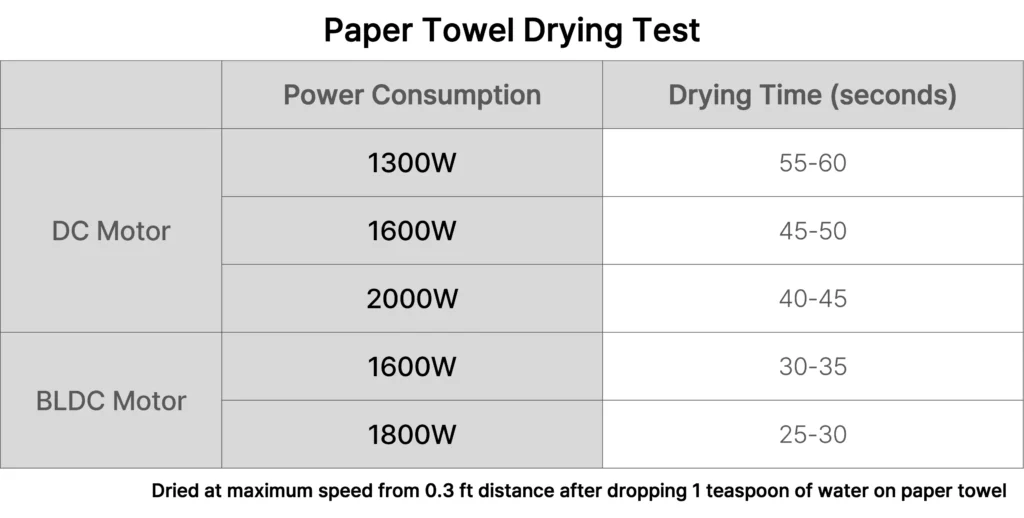
Though higher-wattage models use more power, they dry hair faster, resulting in similar overall energy consumption. Given the relatively short usage time of hair dryers, there’s no need to choose lower-wattage models just to save on electricity costs.
5. hair dryer Air Inlet
Detachable Air Inlets Help Maintain Airflow Performance
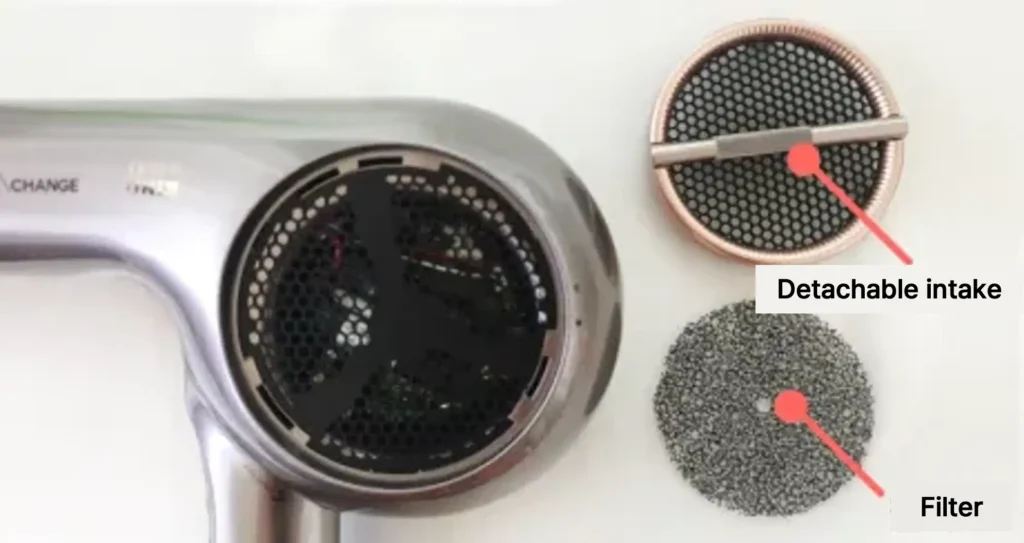
When the motor draws in air, dust and debris can accumulate in the inlet and inside the dryer. This buildup reduces air intake and output, weakening airflow. It can also cause motor overheating and malfunction.
Therefore, choose models with filters or detachable inlets for easy regular cleaning and maintenance.
Chapter 2.
Styling Performance
Features to Check for Hair Health and Styling
Inexperienced use or prolonged styling with a hair dryer can lead to split ends, frizz, and other hair damage, making styling more difficult. Let’s examine what features to look for to make styling easier.
1. Temperature Control
Recommend Models with Separate Temperature and Airflow Controls
Cool Shot Button Adds Convenience
Separate Controls Better for Styling
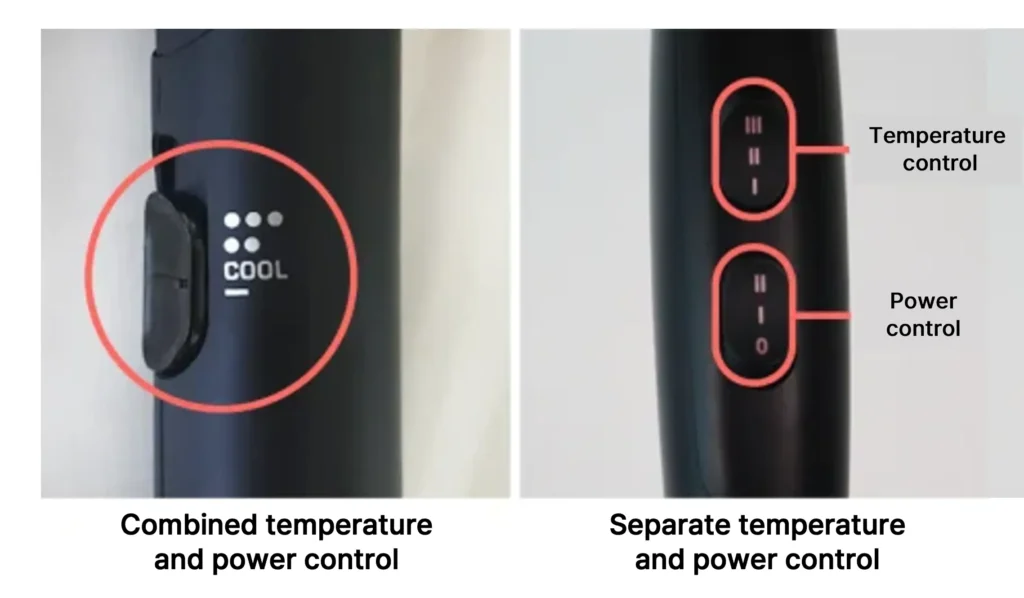
Hair dryers come in two types: unified control (single button) and separate control models. While unified control models are simpler to use since they control both motor and heater with one button, they have limitations.
As airflow increases, so does temperature, making it difficult to achieve:
1) Cold air + strong airflow
2) Hot air + gentle airflow
Cool Shot Button Enables Quick Temperature Changes
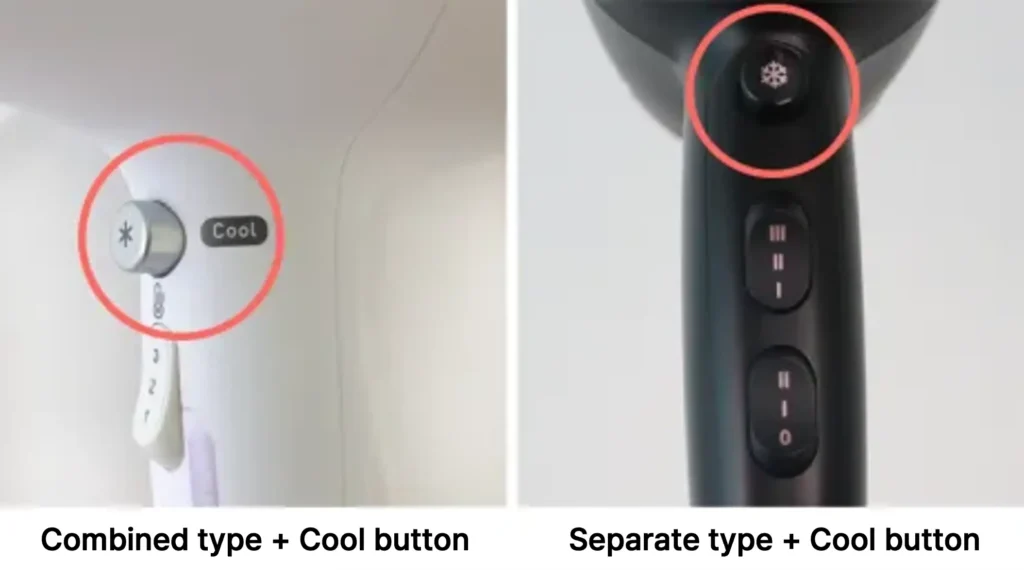
Unified control models with a cool shot button can provide cold air + strong airflow combinations. (Some separate control models also include a cool shot button.)
At hair salons, you’ll notice stylists alternating between cool and hot air while drying wet hair, often using the cool shot button.
Since hair and scalp damage mainly occurs from prolonged exposure to hot air, it’s advisable to choose models with either a cool shot button or separate airflow and temperature controls.
2. Temperature Control System
Digital Temperature Control Prevents
Hair Damage by Maintaining Consistent Heat
Even with adjustable temperature settings, most hair dryers can overheat during extended use. This can cause the output air temperature to keep rising, potentially damaging hair with excessive heat.
To address this issue, newer high-performance models feature digital temperature control systems that monitor heating plate temperature and regulate heater on/off cycles to maintain consistent airflow temperature.
BLDC Motors Better at Maintaining Cool Air
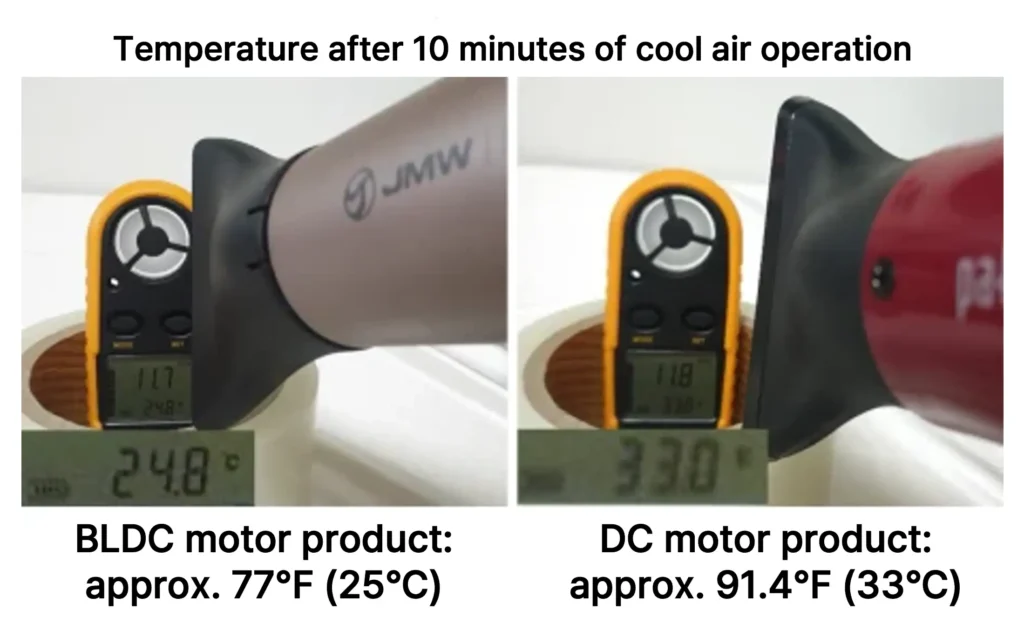
DC motor models, which generate more heat, may start at room temperature when using the COOL button but can reach over 86°F as the motor warms up, sometimes producing lukewarm air even in cool mode.
In contrast, BLDC motor models generate less heat, allowing for quicker cool air transitions and better temperature stability.
3. Negative Ion Function
Helps Reduce Static Electricity
No Proven Hair Health Benefits
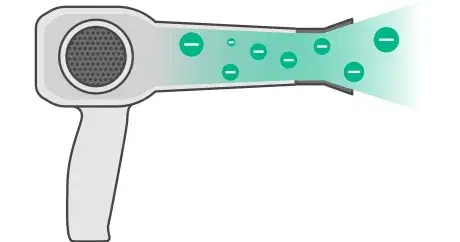
Manufacturers’ claims about negative ions improving hair health aren’t scientifically proven. The negative ion function ionizes oxygen to neutralize positive ions in hair, potentially reducing frizz and static.
However, the effect isn’t significantly noticeable, and there’s no direct benefit to hair health, which is why manufacturers are moving away from emphasizing this feature.
While the ionization process produces trace amounts of ozone, it’s not harmful to health but good ventilation is recommended.
No Radon Emissions
Some consumers worry about radon emissions from ionic devices. Negative ions are generated through either mineral emissions or electrolysis. Since radon only comes from mineral-based methods, hair dryers using electrolysis don’t emit radon.
4. hair dryer Nozzle Types
Check Nozzle Options for Various Styling Needs
For drying entire head of hair, you need wide air distribution, which is handled by the standard 0.6 to 0.8-inch width nozzle. Beyond basic drying, different nozzles can enhance styling effectiveness.
Narrow Nozzles for Waves and Focused Styling
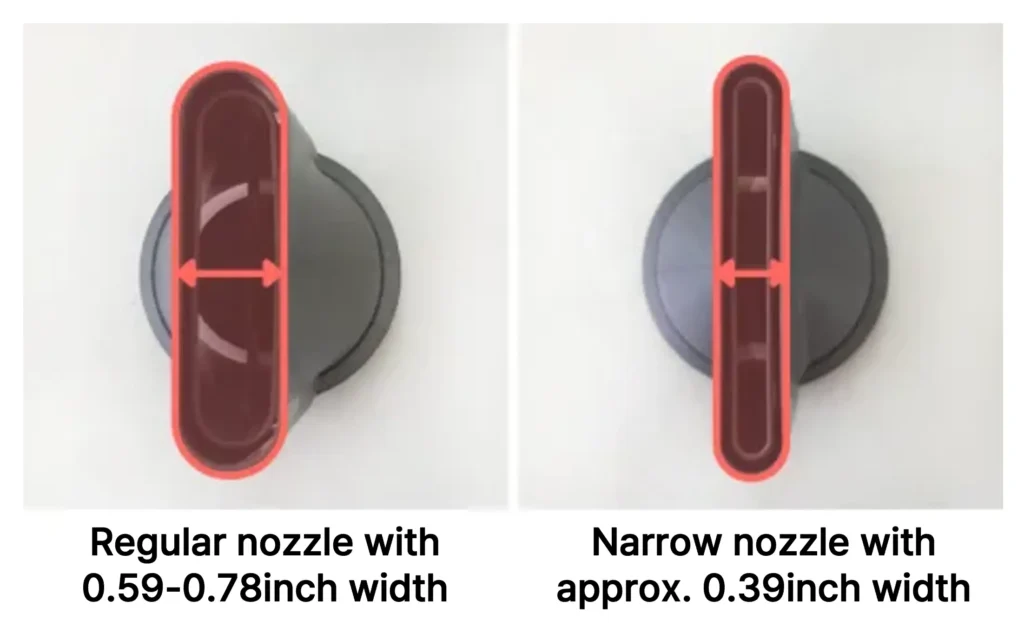
For creating waves and targeted styling, it’s beneficial to concentrate airflow on specific sections. Look for models that include narrower nozzles around 0.4 inches wide for concentrated airflow.
Volume Diffuser for Overall Volume
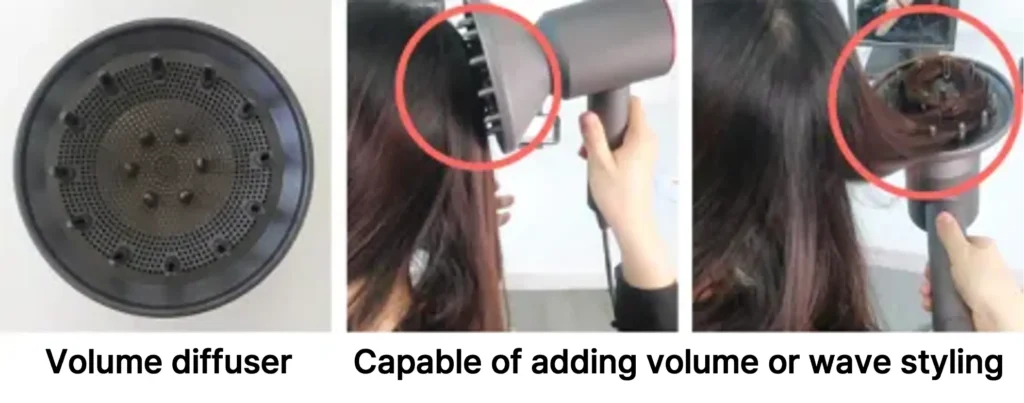
Some models include volume diffusers that direct air close to the scalp over a wider area to create overall fullness.
While effective for adding volume when used correctly, these can be challenging for novice users. We recommend testing the diffuser in-store before purchasing if possible.
Chapter 3.
hair dryer Ease of Use
Features to Check for Convenient and Safe Use
1. Weight
Recommend Models Under 1.1 Pounds
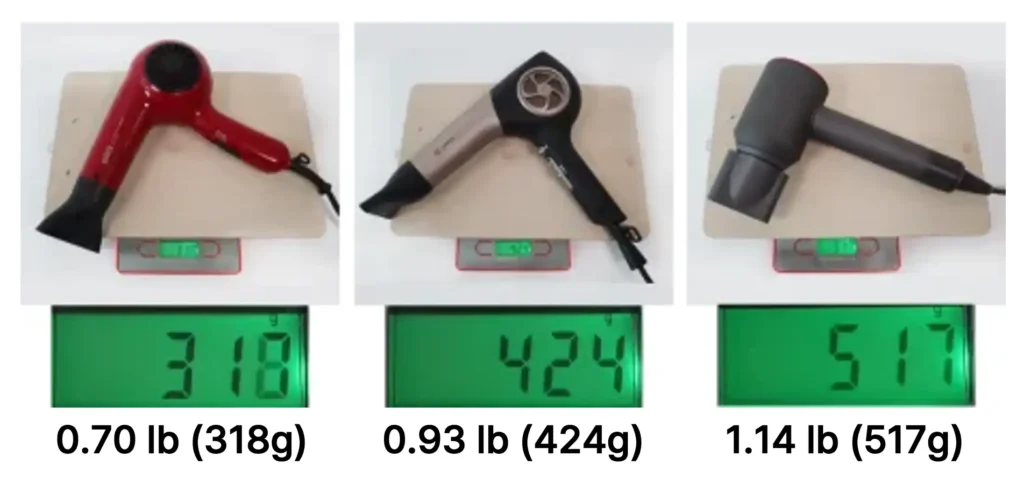
While weight might not be crucial if you have short hair or only need quick drying, a heavy hair dryer can become burdensome for those with long hair or who frequently style their hair.
Based on various consumer reviews and professional hairstylists’ preferences, models weighing less than 1.1 pounds (500g) are generally comfortable to use.
2. Noise Level
No Hair Dryer is Truly Quiet
Though BLDC Motors Are Slightly Quieter
BLDC Motors Are 5 to 10dB Quieter
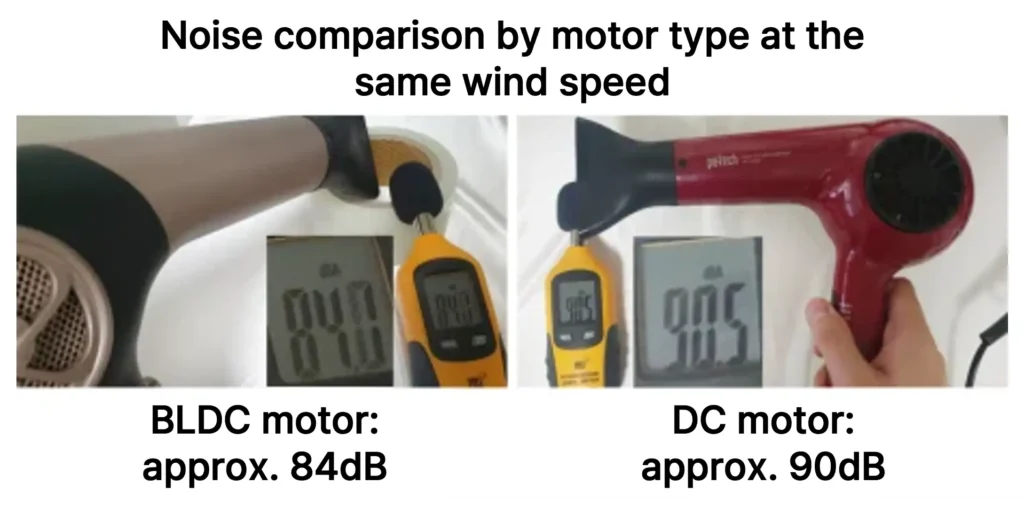
Since hair dryers are used close to your ears, noise can be a concern. Our tests show that BLDC motors are typically 5 to 10dB quieter than DC motors at similar airflow levels.
However, at maximum power, the strong airflow creates significant noise, making the quieter motor less noticeable. When testing 12 different models at maximum power, noise levels ranged from 89 to 93dB with minimal variation.
Power Consumption Doesn’t Significantly Impact Noise
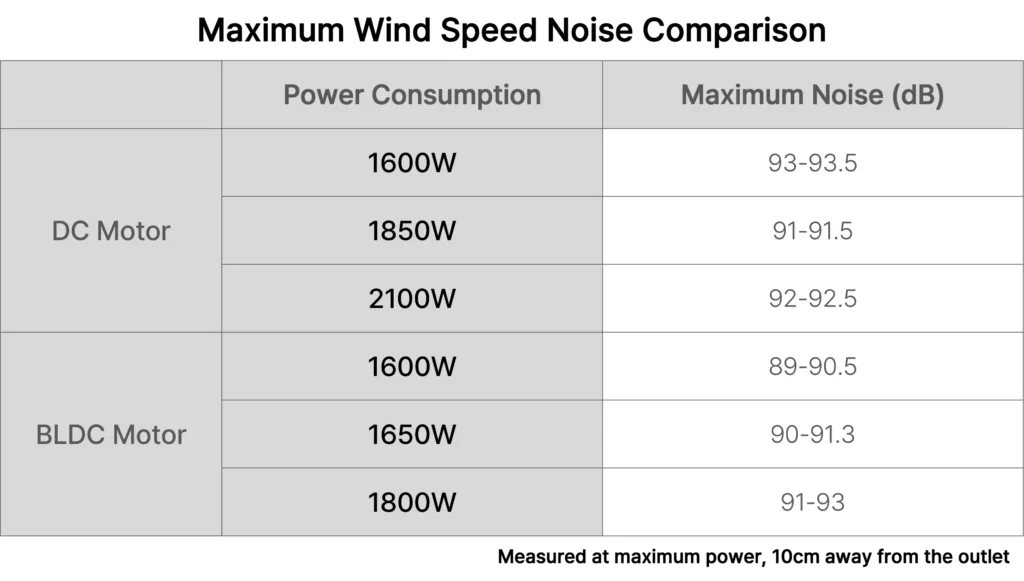
Lower power consumption doesn’t necessarily mean quieter operation. Therefore, choosing a product based solely on noise level isn’t particularly meaningful. If you want the quietest possible option, we recommend using a BLDC motor model at lower power settings.
3. Power Cord
Recommend Thick, Round Cord at Least 6.5 Feet Long
The ideal cord length depends on your outlet locations. While cord length might not matter much in bathrooms or powder rooms with high outlets, for living rooms or bedrooms with lower outlets, a cord length of at least 6.5 feet (2m) ensures comfortable use.
Use Thick Round Flexible Cord for Anti-Tangling and Safety
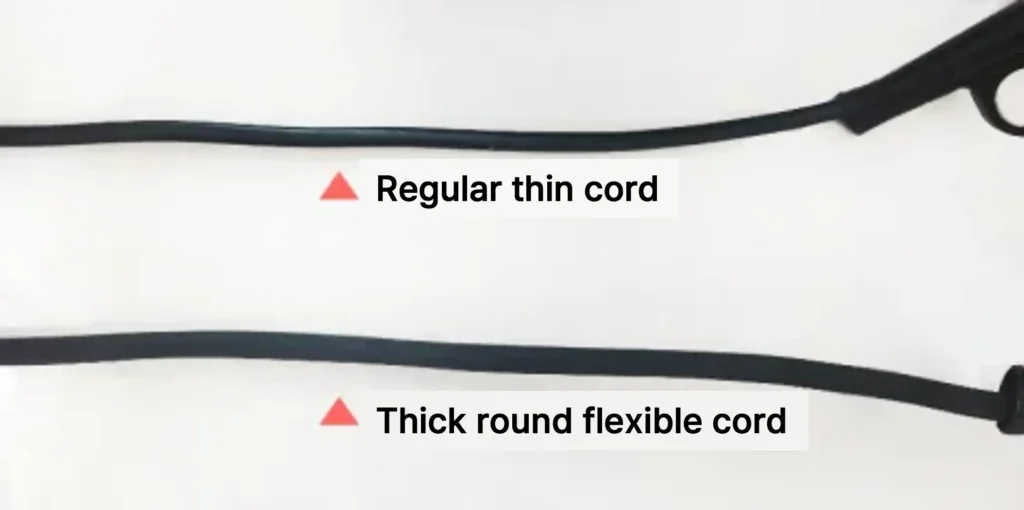
Thin cords tend to tangle frequently and can be inconvenient. Some users report thin cords getting damaged when crushed by chair rollers or heavy objects. Choose models with thick, round, flexible cords that resist tangling and physical damage.
4. Safety Features
Recommend Auto Shut-off
Heat-Shield Nozzle Optional
Auto Shut-off Through Bimetal or Thermal Fus
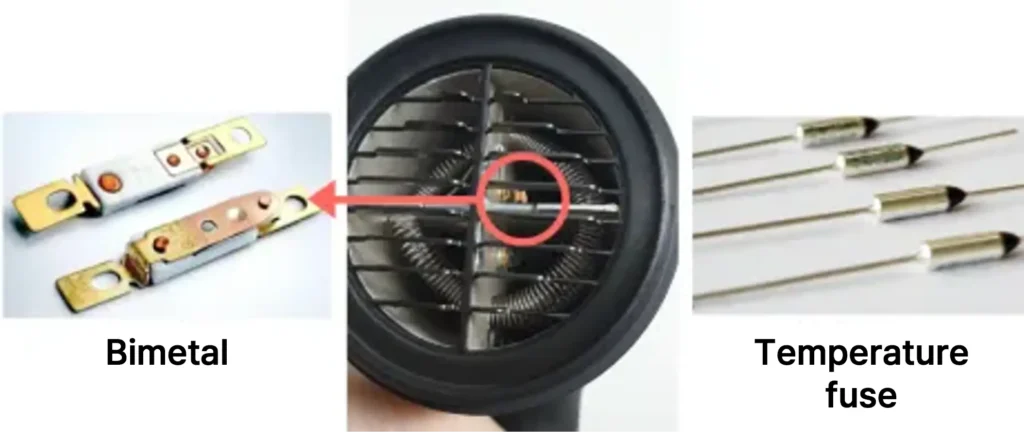
If you’ve ever used a hair dryer to dry clothes, you might have experienced it suddenly shutting off after extended use.
This is due to bimetal switches and thermal fuses that automatically cut power when temperatures exceed safe levels.
When the nichrome wire-connected bimetal reaches a certain temperature, it stops operation, or if overheating occurs, the thermal fuse breaks the circuit.
While most models include this essential overheating and fire prevention feature, it’s worth confirming before purchase.
Heat-Shield Nozzle Prevents Overheating
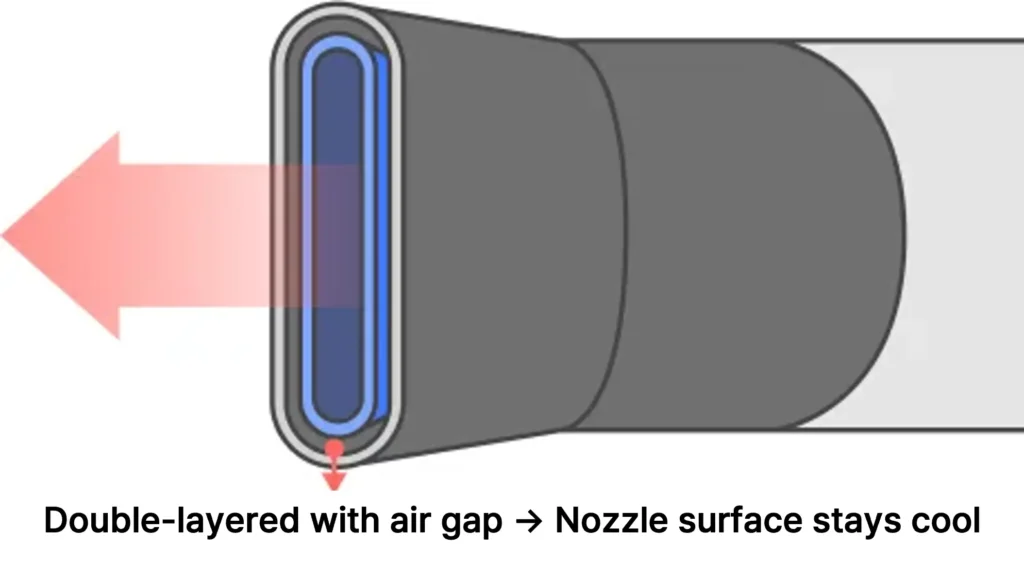
During extended use with hot air, nozzles can become very hot. In severe cases, contact with an overheated nozzle can cause burns. Some models feature double-insulated nozzles to prevent surface overheating.
However, since heat-shield nozzles aren’t widely available and aren’t crucial with careful use, consider this an optional feature based on your needs.
5. Electromagnetic Fields (EMF)
Hair Dryers Emit High EMF
Use with Nozzle Attached and Minimize Usage Time
Hair dryers emit relatively high levels of electromagnetic fields compared to other appliances, which can be concerning given their close proximity to the body during use.
While all models sold must meet EMF emission standards (though specific levels aren’t disclosed), you can significantly reduce EMF exposure by following these two guidelines:
1) Always use with the nozzle attached and maintain at least 4 inches (10cm) distance
2) Use at lower temperatures and keep usage time brief


